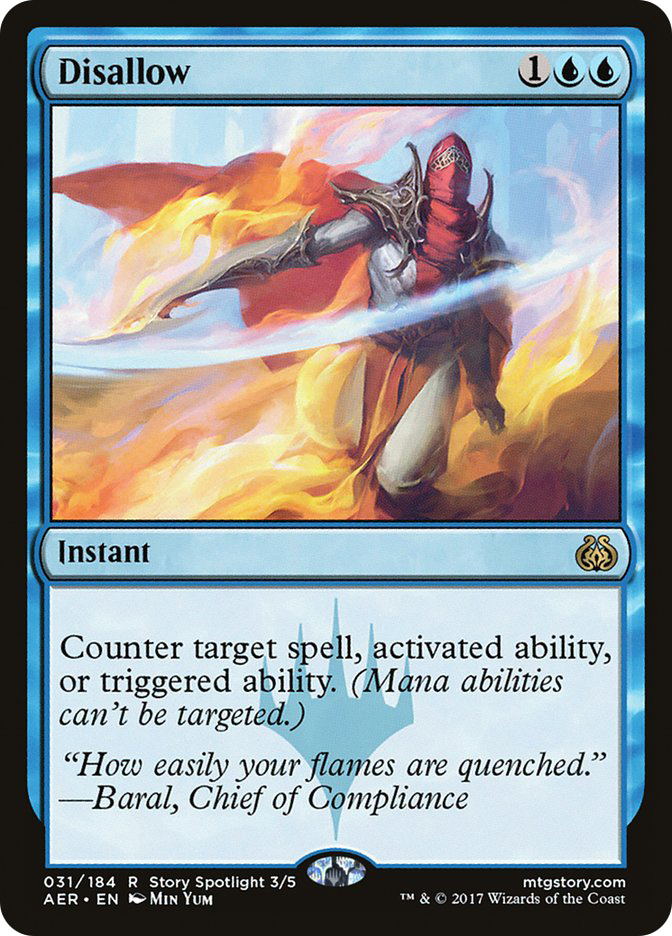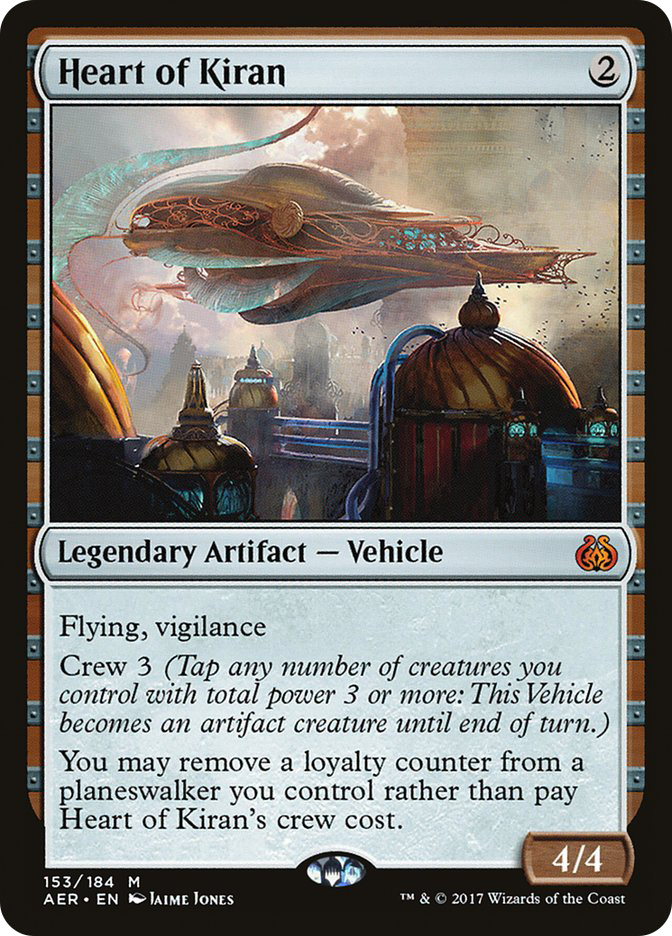Although Aether Revolt comes out next Friday, the rebellion has already started.
These Standard bans are the first of their kind in six years. The last time Wizards of the Coast inflicted a Standard ban, Jace, the Mind Sculptor and Stoneforge Mystic had teamed up to create an oppressive environment of exceptional flexibility and reliability. Both were removed from the format, but even without those two engines, its trademark deck, lovingly (or angrily) called “Caw-Blade,” continued to succeed on the backs of Squadron Hawk, Sword of Feast and Famine, and Celestial Colonnade and dominate for months following the ban, winning local events and worldwide bouts alike.
Standard is much different now than it was in 2011. The format in general has become tighter, more closely monitored, and, in reality, far more successful than it was just a few years ago. The power level of Standard is also much lower. Many of the cards that were on-par with Standard several rotations ago would be unthinkable today. Snapcaster Mage, Thragtusk, Restoration Angel, and Dismember were all playable cards at the time, but in Modern, these are still staples. Fewer and fewer cards make the Standard-to-Modern jump these days, and that’s thanks, in part, to a more focused and less broadly applicable power level.
What that means is that Standard is more fragile. A mismatched card can have a gargantuan impact on the format, and everyone’s deck must realign to answer the new threat. For those who don’t, brewers and the like, they’ll be beat down by that one (or three) cards that throw their weight around the best. Each of these three cards was banned for an explicit reason, and each one, in my opinion, deserved it.
The thirteen-mana price tag put people off Emrakul, the Promised End early in her tenure in Standard. Even with the reductions possible through a heavily dedicated Delirium deck, the complexity and micro-adjustments needed to keep a deck like that tuned to a shifting metagame meant it didn’t catch on as quickly as it might have in, say, Rise of the Eldrazi Standard. It didn’t take long until the best builders in the format discovered ways to get Emrakul, the Promised End out “fairly,” through the calculated application of delirium. She was powerful but manageable, kept in check by aggressive red and white decks and tricky, flashing Spirits.
However, in a world with ways to cheat Her Tentacleness onto the battlefield like Aetherworks Marvel, combined with the consistency that cards like Attune with Aether provide, it didn’t take long before “first Emrakul hit wins” became the mantra of the format’s most prominent players. Stealing a turn so early with a 13/13 flyer was nearly impossible to beat.
Even the B/G Delirium decks that emerged before Kaladesh didn’t have to worry about adjusting to the metagame: they were the metagame. For every other deck, Emrakul, the Promised End was the top-end they wanted and the top-end they hated.
For me, Emrakul’s ban is about preserving the game’s integrity; few decks could answer an early Emrakul, and requiring everyone to do so made the format quite un-fun for many.
The golden child of the Open in Indianapolis, Kaladesh’s first Standard tournament. 32 copies in the Top 8 that weekend, if I recall, and suddenly, a Standard jack-of-all-trades was born. You need card filtering? Got it! Short clock on life? No sweat! Planeswalker pressure? Forget about it! This unassuming 3/3 flyer did a lot to make the format consistent, high-impact and, well, homogenous. You see, Smuggler’s Copter is a great card, but it’s cheap, colorless, and evasive, meaning that deckbuilding centers around making Smuggler’s Copter work as frequently and effectively as possible. R/W Vehicles decks, like Chris VanMeter’s from that first week, showcase how aggressive decks can use the looting ability to stay relevant. Slower decks can use the Copter to stop an early onslaught and go on offense if needed.
It did a little bit of everything, but it also made every player ask a question when creating a new deck, either from scratch or as a patchwork of two or more ideas: “Can it beat an on-time Smuggler’s Copter?” For many brewers, this meant maindecking solid but questionable choices like Natural State, Aether Meltdown, or other instant-speed answers to thwart the Copter. At the end of the day, people took on a can’t-beat-’em-join-’em attitude, and thus, Smuggler’s Copter was the most common turn 2 play in Standard.
Smuggler’s Copter’s ban is an attempt to preserve the game’s versatility. Every color and strategy can’t have such a powerful, flexible tool. Like Emrakul, the Promised End, the first one cast is often way better than the second.
This one seems a bit late to me. With Collected Company rotated out, Reflector Mage is considerably less scary than it could be. Still, I think this is a good choice because of how powerful Reflector Mage is in the abstract. Emrakul, the Promised End needs some help to make her good, but it makes her exceptional. Smuggler’s Copter needs one-power creatures to be efficient and impactful.
Reflector Mage needs an Island and a Plains.
As a three-mana creature with an enters-the-battlefield effect, Reflector Mage is a considerable step above the average uncommon offering in a small set. None in recent memory have had such a brutal impact on fair Magic. Depriving an opponent of a creature for two turns could make Reflector Mage a Shriekmaw in a surprising number of battlefield states. The indiscriminate removal that the Mage provided was intensely powerful and, when appropriately leveraged, completely prevented some opponents from ever getting into the game. If you fell behind, Reflector Mage shut the door, but in a way that comes from solid play.
Instead, Reflector Mage made opponents feel bad for doing what Magic has, at least recently, been all about: playing creatures. Reflector Mage’s extra power of toughness was an extra kick while we were down: Aether Adept and Man-o’-War have two toughness, and we’re totally content to play them in Limited. The extra toughness plus the Time Walk effect can be backbreaking. One of the strongest tempo cards created in recent years, Reflector Mage ended up in all the decks best designed to exploit its otherwise conditional effect. Its worst deeds were done before Kaladesh came out, but in a new format where fair creature decks will reign supreme, a card that consistently denies this most basic of Magic actions doesn’t belong. At the end of the day, I think banning Reflector Mage preserves Magic’s playability. If Reflector Mage were left to run free in a world dominated by creatures, it could still be top dog.
Why Standard Bans Matter
The other two bans announced Monday also have a huge impact. Gitaxian Probe, a free deck-shrinker and Storm-builder, may not have necessarily been banworthy in my book, but I understand the sentiment. Golgari Grave-Troll, on the other hand, was the right choice. Not only had Dredge grown in power thanks to some timely Shadows of Innistrad additions, but I think that Golgari Grave-Troll betrayed the spirit of dredge in the first place.
My guess is, in Ravnica, the idea behind dredge was to provide you, for a small cost, the ideal spell in hand to replace your draw. Darkblast wasn’t always a good card, but sometimes it was better than a random card off the top. I’ve cast Stinkweed Imp; sometimes, you just need a blocker with pseudo-deathtouch. Golgari Grave-Troll? No one ever casts it. The entire card could be blank text except for “Dredge 6” and it would see play in the vast majority of its current applications. This kind of cherry-picking isn’t really in the spirit of dredge, even though it’s long been bent to the competitive player’s will. As such, I appreciate the practical and acknowledging nod to this possibility.
Modern bans have been more common than Standard bans, there’s no doubt. However, I think Standard is easier to ban from.
Think about it: if, all of a sudden, Wizards of the Coast decided to ban Blood Moon, there would be a hue and cry from the ranks of Modern’s playerbase. “I spent $200 on a set of 9th Edition foil Bloom Moon!” “My Blue Moon deck is ruined!” “How are we supposed to beat Tron now?”
Standard bans? Far more players, far less to lose. Standard changes quickly as it is, so it’s important to understand its role in the competitive landscape of Magic. With considerably less investment, Wizards of the Coast can ban certain cards in Standard. The format is already fairly fluid, and its health is important to Magic.
Like it or not, Standard is Magic’s most popular format. Wizards of the Coast brings in all sorts of players with Standard, and it’s easily accessible to a people of all skill levels. Chances are, if your shop has one tournament a week, it’s Standard. Thus, the health of the format for both new and seasoned players is far more important than any other. These kinds of bans are minimally impactful financially for players, they keep the most played format in Magic fresh, and it spurs on the development of brews and counterbrews. I’m telling you, bans are a great thing.
Aether Revolt Speculations
With all this talk of the impact these bans will make, it’s important to remember that Aether Revolt is just around the corner. In a way, we’re getting two new formats next Friday: one without the three banned cards and one with 184 new ones to play with. Unlike in years past, tried and true decks can’t just add the nominal upgrades offered in a small set expansion. Instead, everyone has to rebuild from the ground up, changing the way we look at the format. For people who’d prepared decks for #SCGCOL, they have to change their gameplan. Sideboards, whole decks will change.
Cards in the preview that you may have overlooked because of their unfavorable match with our three banned cards? Maybe they get a bit better.
Each of these spells had a better version that’s either no longer needed or now viable. Summary Dismissal, perfectly designed to erase Emrakul, the Promised End, might fall in favor to the cheaper, more flexible Disallow. Heart of Kiran, already a strong counter to Smuggler’s Copter, may harass your opponent’s life total unchecked. Solemn Recruit, one of the many cards weak to soft removal, became more terrifying with the prospect of harder, tempo-spoiling removal need to stop it.
With a more stable format on the horizon, any good card has the potential to rise above its peers.
Conclusion
My thoughts? I’m elated. I don’t think it was intentional, but I think that a format-altering ban is the perfect way to usher in a set called Aether Revolt. The ban will turn Standard upside down. Brand-new strategies that didn’t feature (or couldn’t beat) the three cards listed now have a chance to shine. Patient brewers are ready to open their binders again. Speculators will start looking in every direction, trying to find the next hot deal.
In the end, we will have a new format on January 20th for two reasons: we lost three big threats, and the next three to replace it will be playing in an all-new world. With a new outlook on the format, I can’t wait to get started brewing. Even with “the man” dead, one will rise to fill its shoes. Let’s fight the new one that takes its place!
Nothing is off-limits again, and it’s inciting…I mean, inspiring!







